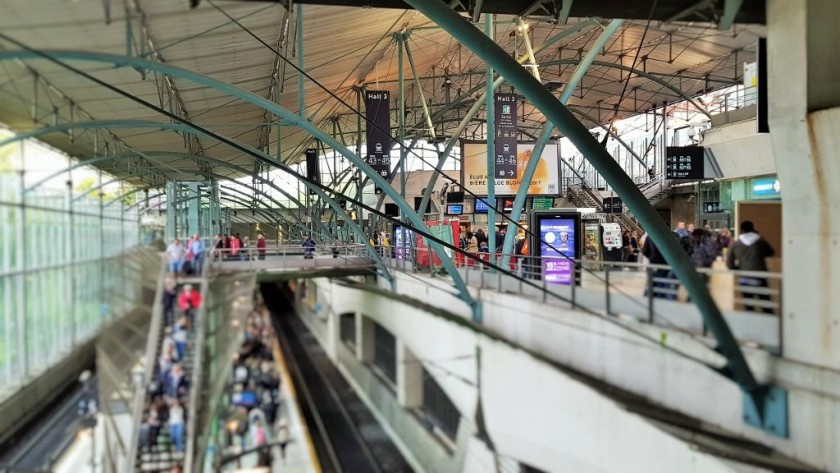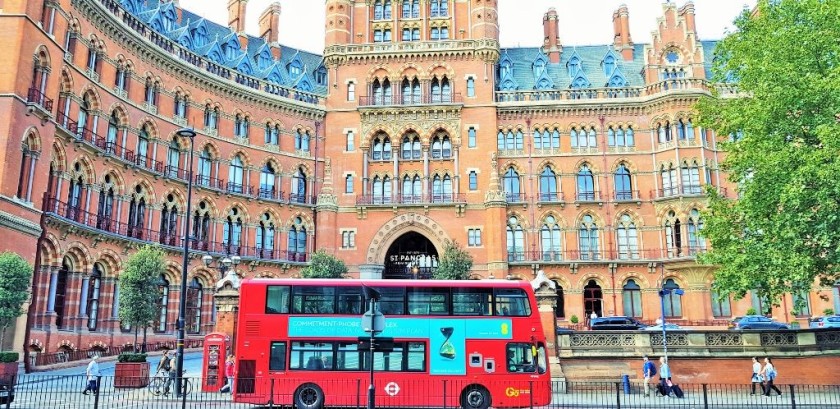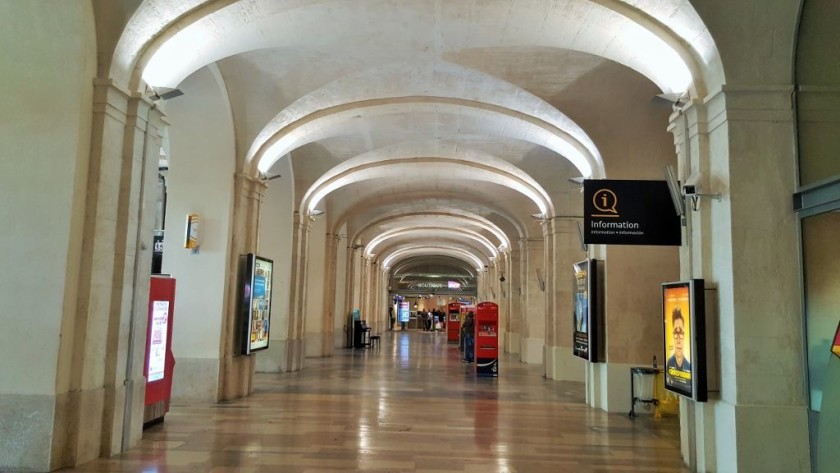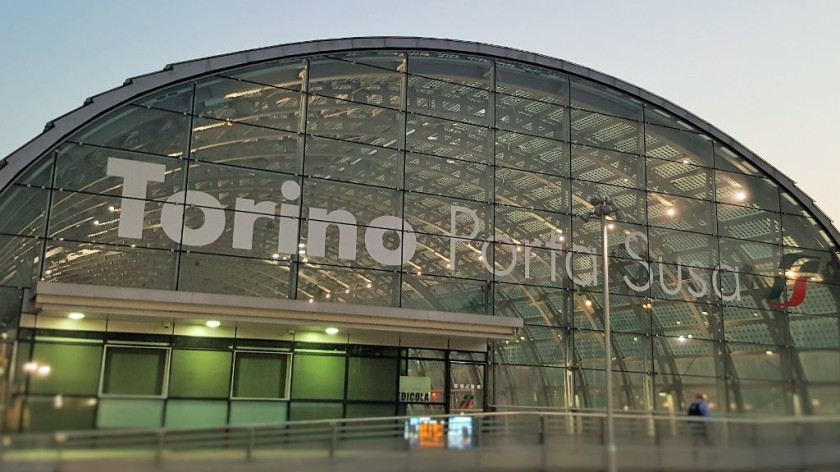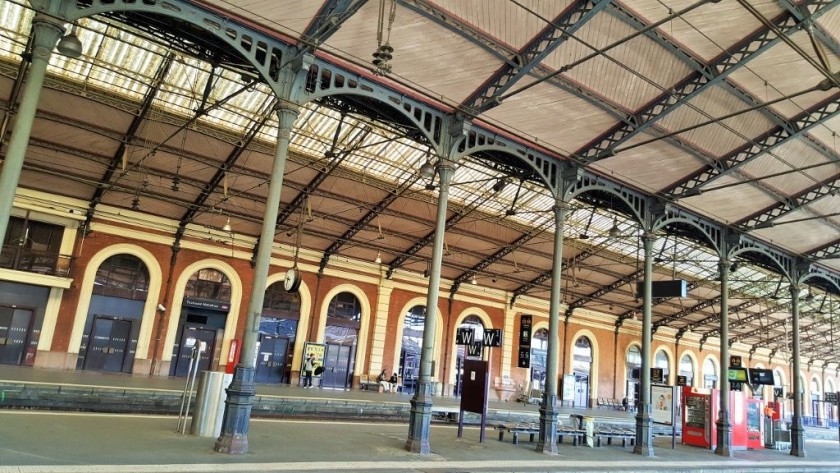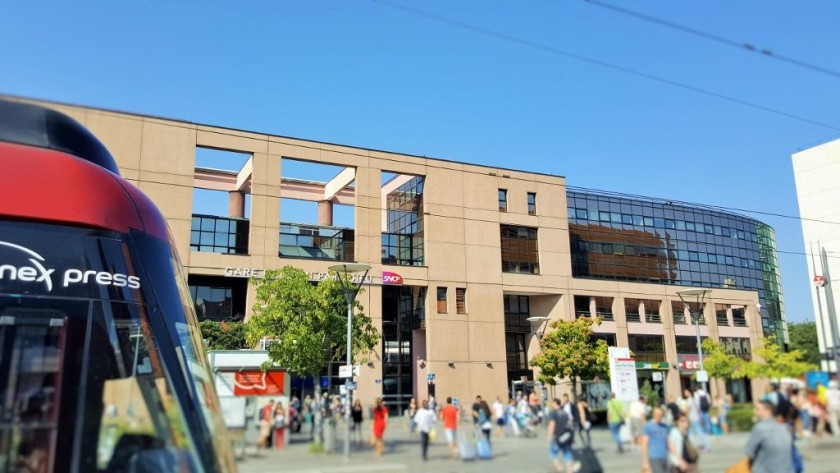Related Content
Content

Lyon Part-Dieu (Lyon)
This guide to using Lyon Part-Dieu train station will help make sense of what can be a bewildering space.
In an effort to make Lyon Part-Dieu less confusing a major program of construction work has commenced at the station.
During this time different parts of the station will be sequentially closed off AND the usual routes through the station and to/from the trains MAY be subject to diversion.
All of the info describes the USUAL means of navigating the station and accessing the trains.
Share
At a Glance
Services
Left Luggage
Travel Information Desk
First Class Lounge
Local Tourism Information
Onward Travel
Metro
Taxi Rank
Accessibility
Step Free
Train service summary
The following train services depart from and and arrive Lyon-Part-Dieu:
- TGV InOui trains to / from Paris Gare De Lyon, Aeroport CDG, Aix-en-Provence TGV, Antibes, Avignon TGV, Beziers, Bruxelles, Cannes, Carcassonne, Colmar, Dijon, Le Havre*, Le Mans, Lille, Luxembourg, Marne La Vallée, Marseille, Montpellier-St Roch, Nancy*, Nice, Nimes, Metz*, Rennes, Rouen*, Strasbourg, St-Etienne, St-Raphael, Toulon, Toulouse, Valence TGV Rhône-Alpes Sud and Versailles*
- Ouigo Grand Vitesse trains to / from Paris Gare De Lyon, Lille, Lyon, Aeroport CDG, Avignon TGV, Marseille, Montpellier-St Roch, Nimes and Valence TGV Rhône-Alpes Sud
- Intercités trains to / from Angers, Nantes, Nevers and St Pierre-des-corps (for Tours)
- SNCF /DB train* to / from Karlsruhe, Mannheim and Frankfurt (Main)
- SNCF / RENFE train* to / from Nimes, Montpellier-St Roch, Narbonne, Perpignan, Figueres-Vilifant, Girona and Barcelona
- Frecce trains to / from Paris Gare de Lyon, Torino and Milano
- TER trains to / from Aix-les-Bains, Annecy, Avignon Centre, Belfort-Ville, Besançon-Viotte, Chambery, Clermont Ferrand, Dijon, Geneve, Grenoble, St-Etienne and Valence-Ville.
*= 1 x train per day
Note that there are no direct trains between Lyon and Bordeaux.
There are detailed travel guides available for many of these journeys.
Note that there are no overnight train services to and from Lyon.


Lyon Part-Dieu was opened in the late 1970s to provide the focus point for a massive extension of the city centre, hence a location, on the opposite bank of the River Rhone to the historic heart of Lyon, where the majority of the city's attractions are located.
Though a tad frustratingly the city's metro system doesn't provide a direct link between Part-Dieu station and this area, the station is on Metro Line B, but it goes north-to south through this newer area of Lyon
So when heading from the station to the core of the city at Bellecour, or the attractions on the opposite side of the city centre, which are on the east bank of The River Saône, a connection is required into Metro line D at Saxe Gambetta station.
Making sense of the station
What makes Lyon Part-Dieu a somewhat confusing railway station for first time users, is that the building which houses the station has a dual function.
It isn't solely a station, it is also a passage way, which links two popular parts of the city and connects some of the tram stops at Part-Dieu to its Metro station.
You will enter Lyon Part-Dieu station either by its Porte Rhône or its Porte Alples entrances.
They are located at either end of that large passage way that is beneath the voies (platforms/tracks) and which houses all of the station facilities.
The voie (platform/track) that each train will be leaving from isn’t usually confirmed until around 15 mins before departure.
So the ground level concourse/passage area often becomes crowded with people waiting for trains.
Though something to keep in mind is that at Lyon Part-Dieu the voies (platforms/tracks) are assigned letters and NOT numbers.
Which can be confusing because each voie (platform/track) is divided into repéres (zones) and these zones are also marked by letters.
On the platforms the zone letters are bigger than those that indicate which voie (platform/track) it is.
Book Accommodation
When planning a trip, finding convenient accommodation can be trickier than working out which train to take.
Hence ShowMeTheJourney has partnered with the innovative accommodation portal, Stay 22, to offer three options for discovering your optimum accommodation:
1: Use the map above to see which hotel rooms and Vrbo rentals, with easy access to Lyon-Part Dieu, are available.
2: Or click on these cherry-picked properties, offered by Stay 22 partner Booking.com, which are by Lyon-Part Dieu and have been selected on the basis of high guest ratings:
Ibis Styles Lyon Centre - Gare Part Dieu
Mercure Lyon Centre - Gare Part Dieu
Ibis Budget Lyon Centre - Gare Part Dieu
3: Or see what's available with Stay 22's accommodation partners; which include, Expedia, Hotels.com and Trivago - by clicking the large button below.
Stay 22 will 'shuffle' the booking services so that you can be automatically directed to its partner that currently has the optimum availability at this location.
Questions Answered
ShowMeTheJourney has anticipated what questions are most often asked about taking trains to and from Lyon-Part Dieu and answered them below.
Though note that some of this info may be temporarily subject to change, due to the ongoing building work [which will transform the station](https://www.lyon-partdieu.com/en/operations/station/).
If you can't find the information you are seeking, you can ask a question and the AI enabled service will try to write an answer, telling you what you wish to know.
Is there step-free access to and from the platforms /tracks?
The voies (platforms / tracks) used by the trains are on a level above the the passage which houses the station facilities
All of the voies (platforms / tracks) can be accessed by lift / elevator, though each pair of voies is only served by one escalator - which are are usually configured so that they lead up TO the trains.
How to travel between Lyon-Part Dieu and the city centre?
The main business district in Lyon has been created in the area around Part-Dieu station, but the historic heart of the city, its 1st_arrondissement, the old town and the centre of the Presqu'île are all more a kilometer to the west of Part-Dieu.
Hence public transport being the best alternative to taking a taxi when making the transfer between Part-Dieu and the heart of the city.
However the line B of the Lyon Metro, which serves Part-Dieu takes a north-south route across the city - mirroring the directions taken by the long-distance trains.
As a result connections between Metro lines are required when travelling between Part-Dieu station and the historic heart of Lyon.
- To and from the 1st arrondissement = take Line B to Charpenes and connect there for Line A trains to Hôtel de Ville L. Prade and to Cordeliers stations.
- To and from the old town area = take Line B to Saxe-Gambetta station and transfer there to a line D train to Vieux Lyon station
- To and from the Presqu'île = take Line B to Saxe-Gambetta station and transfer there to a line D train to Bellecour station
How can tickets purchased for the public transport connections?
The ticket office for the Part-Dieu Metro station is open on Monday to Friday from 7:30am to 7pm and on Saturday from 9am to 6pm
Though there are numerous ticket machines available - and the public transport provider, tcl, keeps things simple with a single ride Metro ticket to any destination costing a flat rate of €2.
A range of other tickets are available for those who want to take multiple journeys.
Are there cafes or restaurants available?
There are two restaurants at the station, Ciao Nonna, which serves Italian food and is located on the Porte Alpes side of the station; And Daniel et Denise, which is located on the Porte Rhône side of the station.
Cafes and fast-food outlets are also available.
Are there left luggage facilities?
Yes there are left luggage lockers, but the access to the facility managed by SNCF can be compromised by the construction work.
Note that access to the left luggage facility is not available 24 hrs.
Does the station have a First Class lounge?
Yes, the station has a Grand Voyageur lounge, which can be accessed by those who will be travelling with Business Premiere tickets, on the TGV InOui services.
Buying Tickets at Lyon-Part Dieu Station
At Lyon Part-Dieu train station the Billetterie/ticket office is divided into two separate offices.
(1) The larger office is for tickets for trains that are departing that day.
The queues can be lengthy - so give the yellow ticket machines a try, they’re relatively easy to use with good English translation.
More info on using the machines is available on our GUIDE to using French train stations.
At busy times there will be SNCF staff available, who speak English, to assist with using these machines. .
But you can only do that on the day you will be travelling.
(2) The smaller booking office, where the staff sit at numbered counters, is where you need to go to make any other advance booking/reservation.
You also need to use this office if you want to collect pre-booked tickets, or make rail pass reservations ahead of your travel date.
In this ticket office you take a number and then wait for it to be called.
Departing by train:

A major reconstruction program has now commenced at Lyon Part-Dieu - the general info on our guide below won't be affected by these changes, but what will differ periodically, is the access routes to the voies (platforms/tracks) that the trains depart from.
When taking a train from Lyon Part-Dieu train station you USUALLY need to take the following steps:
(1) Check the information on your ticket, in particular the departure time and the four digit train number.
You'll find this number on your ticket, below the station you will be travelling to and to the right of the type of train you will be travelling by.
The main departure board does not show every station that trains will be calling at, but it does show the departure times and the train numbers; so If need be, match the train number on your ticket to the train number on the board.
There are no paper departure posters at Lyon Part-Dieu, on which you can check the details of where trains will be heading and at what time.
(2) Confirm which voie (platform/track) your train will be departing from using the electronic train departure screens.
More info is about understanding these screens is available on our GUIDE to using French stations.
There are large black indicators by each of the main entrances - and smaller blue screens scattered around the station.
Watch the screens carefully, the voie (platform/track) is usually not confirmed until around 10-15 mins before departure; which can prompt a stampede, but take your time.
At Lyon Part-Dieu the voies (platforms/tracks) are assigned letters and not numbers .
(3) There are escalators and lifts up to each voie (track/platform).
The staircases, which are a dominant feature of the station, are mainly for the use of travellers arriving by train.
If you have a ticket issued by a machine or ticket office don't forget to stamp it in the machines before heading up to the voie.
It can be a good idea to do this when you first arrive at the station.
(4) On the voie (platform/track) there will be an electronic next train to depart screen - this will show all the stations that the train will be calling at.
It also shows which carriage/coach of the train will occupy each zone/repére on the voie (platform/track) when it arrives.
The voies (platforms/tracks) are divided into zones marked by letters - and at Part-Dieu these letters on the signs are larger than the letters, which indicate which voie you are on.
(5) Boarding the train will be much easier if you are waiting in the appropriate zone/repére when the train arrives.
If you will be travelling by TGV, the voiture (coach) number that your reserved seat(s) is located in, will be on your ticket.
So look for it on your ticket - and match it to the coach numbers on this departure screen.
Arriving by train:

A major reconstruction program has now commenced at Lyon Part-Dieu - the general info on our guide below won't be affected by these changes, but what will differ periodically, is the access routes FROM the voies (platforms/tracks) that the trains arrive
If you don’t have luggage - the quickest routes to the exits is to take the stairs down to the concourse beneath the platforms.
If you do have luggage etc. then don’t follow the crowds, there are escalators and lifts available.
There are TWO MAIN EXITS from the station;
(1) The Porte Rhône exit
The Metro station is outside the Porte Rhône exit - over to the right.
Also use the Porte Rhône exit if you want to transfer to tram line T1 - this tram goes to Perrache station (direction Debourg).
(2) The Porte Alpes exit
Use the Porte Alpes exit if you want to take tram lines, T3 and T4 - or take the Rhônexpress tram to the airport.
If you are changing trains, check the blue screens that show the subsequent departures, - before exiting the voie (platform/track).
If you’re fortunate, your next train may also be departing from the same voie (platform/track) that your train has just arrived at.
Lyon-Perrache station:

Lyon has two main railway stations and its other main station is Lyon Perrache station.
Lyon Perrache is closer to the city centre and old town district, while Lyon Part-Dieu station is to the east of the city centre, in the main business area.
So before making the train journey to Lyon, check the location of your final destination in the city and purchase tickets/a ticket to either Lyon-Part-Dieu OR Lyon Perrache.
If you have a ticket valid to Part-Dieu, it technically won’t be valid for the journey on to Perrache.
The train services at each station
The majority of the TGV trains to and from Lyon only call at Lyon-Part Dieu, the main exceptions are the TGV InOui services to and from Paris - when travelling from the French capital these trains call at Part-Dieu before going on to Perrache, so in the opposite direction they commence their journeys at Perrache and then call at Part-Dieu.
Some Ougio services to and from Lyon only use Perrache station and the Intercités trains to and from Nantes also call at both Part-Dieu and Perrache.
The TER trains between Lyon and Bourg-en-Bresse, Clermont-Ferrand and Roanne, typically depart from and arrive at both Part-Dieu and Perrache.
Though when travelling between Lyon and St Etienne, Villefranche-s-Saone and Vienne, the faster services go to and from Part-Dieu and the slower services to go to and from Perrache.
The TER trains between Lyon and Annecy, Aix-les-Bains, Avignon, Dijon, Geneve, Grenoble and Valence typically only use Lyon-Part Dieu.
Metro connections:
Lyon Perrache is on Line A of the Lyon Metro, while Part-Dieu is on Line B - which connects to Line D at Saxe-Gambetta station
Though the connection between the rail station and metro station at Perrache is an awkward transfer.
If your final destination or starting point in Lyon, is in the area around Bellecour metro station - heading to and from Bellecour on a combination of the Line B at Part Dieu and Line D metro, connecting at Saxe Gambetta, is quicker and easier than using line A between Perrache and Bellecour.
Transferring between Part-Dieu and Perrache stations:

The easiest option for making the transfer between the two main railway stations in Lyon is to take a train between Part-Dieu and Perrache, but there can be gaps of nearly an hour between departures.
There is no direct Metro line between Part-Dieu and Perrache stations, so not only do you have to change lines, making the transfer at Charpennes Charles-Hernu station; the metro is also a roundabout route.
Charpennes Charles-Hernu is to the north of Part-Dieu, but Perrache is actually located to the west; hence, when no train is due, using the tram is a better option than taking the metro.
If no trains for Perrache are departing from Part-Dieu within the next 25 - 30mins, it will be quicker to take the tram, rather than waiting for a train.
Trams on line T1 (direction Debourg) depart from every 5-10mins from the 'Vivier Merle' tram stop.
Use the Porte Rhône exit from station and this tram stop is to the right of the pedestrian area in front of the station - the Place Charles Beraudier.
When you arrive at Perrache don't alight at the stop named 'Perrache; instead leave the tram at the next stop, named Place des Archives, as it is closer to a new entrance to the rail station, which also offers step-free access to the trains.
To Fourviére from Part-Dieu
The easiest access to the historic Fourviére area from Part Dieu is to:
(1) take Metro line B (direction Ouillins) two stops to Saxe Gambetta station - where you can make transfer to Metro Line D (direction Vaise).
(2) From Saxe Gambetta station, take the Metro Line D three stops to Vieux Lyon station.
(3) At Vieux Lyon station connect into the funicular for Fourviére.
Transferring between Part Dieu And Saint-Exupéry Airport:
Lyon’s Saint-Exupéry Airport isn’t linked to Lyon’s Metro, but an express tram service, the Rhônexpress, provides a direct link between the airport and Part-Dieu station - the journey takes around 30 mins.
FROM PART-DIEU: The Rhônexpress tram stop is outside the Porte Alpes exit, as you leave the station building, the tram stop is on the far right.
FROM SAINT EXUPÉRY: The tram stop is just outside Lyon Saint-Exupéry TGV station - a moving walkway connects the airport terminals to.the station.
If Lyon Saint-Exupéry TGV is the only station call your train is making in the Lyon area, you can use the Rhônexpress to transfer to Part-Dieu station.
From the airport to Lyon city centere:
The Rhônexpress also calls at Vaulx-en-Velin La Soie station - where transfer is possible to Lyon Metro Line A.
If you’re travelling between Saint-Exupery and the city centre, making this connection into Metro Line A here, is a quicker and easier option than taking the Rhônexpress from/to Part-Dieu.
City Guides
France's second city is inevitably packed with attractions, which make a train trip to Lyon worthwhile.
Top Things To Do In Lyon (Lonely Planet)
15 Recommendations from a Lyon Resident (Ashley Abroad)
Unusual Attractions in Lyon (Atlas Obscura)
15 Top Rated Attractions (Planet Ware)
10 Free Things To Do In Lyon (The Good Life France)
Journeys
# Jump to a directionJourneys from Lyon Part-Dieu
Jump to directionsLyon to Aix - en - Provence by train
Lyon to Aix - les - Bains by train
Lyon to Albertville by train
Lyon to Annecy by train
Lyon to Antibes by train
Lyon to Arles by train
Lyon to Avignon by train
Lyon to Barcelona by train
Lyon to Béziers / Beziers by train
Lyon to Bruxelles / Brussels by train
Lyon to Cannes by train
Lyon to Carcassonne by train
Lyon to Dijon by train
Lyon to Frankfurt by train
Lyon to Genève / Geneva by train
Lyon to Grenoble by train
Lyon to Lille by train
Lyon to London by train
Lyon to Marseille by train
Lyon to Milano / Milan / Mailand by train
Lyon to Montpellier by train
Lyon to Moûtiers / Moutiers by train
Lyon to Mulhouse by train
Lyon to Nantes by train
Lyon to Narbonne by train
Lyon to Nice by train
Lyon to Nîmes / Nimes by train
Lyon to Paris by train
Lyon to Rennes by train
Lyon to Strasbourg by train
Lyon to Torino / Turin by train
Lyon to Toulon by train
Lyon to Toulouse by train
Journeys to Lyon Part-Dieu
Jump to directionsAmsterdam to Lyon by train
Barcelona to Lyon by train
Bruxelles / Brussels to Lyon by train
Frankfurt to Lyon by train
Genève / Geneva to Lyon by train
Köln / Cologne / Koeln to Lyon by train
Lille to Lyon by train
London to Lyon by train
Marseille to Lyon by train
Milano / Milan / Mailand to Lyon by train
Paris to Lyon by train
Torino / Turin to Lyon by train
This second version of ShowMeTheJourney is exciting and new, so we are genuinely thrilled that you are here and reading this, but we also need your help.
We’re striving not to let anything get in the way of providing the most useful service possible, hence a facility has been set up with DonorBox which can be used to support the running costs and make improvements.
Instead of advertising or paywalls, your financial support will make a positive difference to delivering an enhanced service, as there’s a lot of ideas which we want to make happen.
So if you have found the info provided here to be useful, please consider saying thank you.

This is one of more than 100 train travel guides available on ShowMeTheJourney, which will make it easier to take the train journeys you want or need to make. As always, all images were captured on trips taken by ShowMeTheJourney.




















